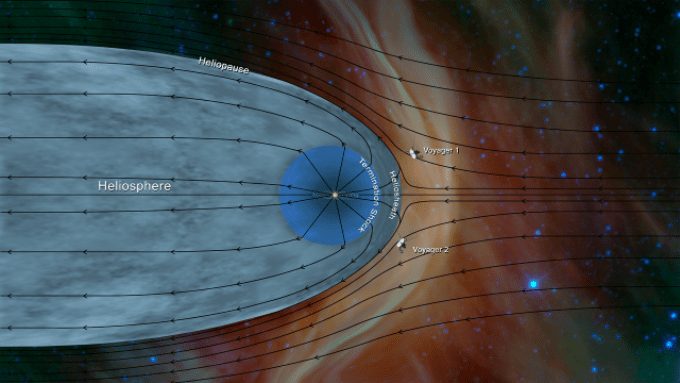Nov 5 2019
In the interstellar space, Voyager 1 now has a companion. According to scientists from The University of Iowa, the Voyager 2 spacecraft has made its way into the interstellar medium (ISM), the space region outside the bubble-shaped boundary created by wind that streams outward from the sun.
 University of Iowa researchers report the spacecraft Voyager 2 has reached interstellar space, following Voyager 1’s historic passage six years ago. In the study, the researchers note a jump in plasma density detected by an Iowa-led plasma wave instrument on the spacecraft as evidence. (Image credit: NASA/JPL-Caltech)
University of Iowa researchers report the spacecraft Voyager 2 has reached interstellar space, following Voyager 1’s historic passage six years ago. In the study, the researchers note a jump in plasma density detected by an Iowa-led plasma wave instrument on the spacecraft as evidence. (Image credit: NASA/JPL-Caltech)
Voyager 2 turns out to be the second manmade object to venture out of the sun’s effect, after Voyager 1’s solar exit in 2012.
In new research work, the scientists confirm the passage of Voyager 2 into the ISM on November 5th, 2018, by observing an obvious jump in plasma density sensed by an Iowa-led plasma wave instrument equipped on the spacecraft.
The evident increase in plasma density demonstrates that Voyager 2 has traveled from the hot, lower density plasma typical of the solar wind to the cool, higher density plasma of interstellar space. Moreover, it is similar to the jump in plasma density experienced by Voyager 1 upon crossing into interstellar space.
In a historical sense, the old idea that the solar wind will just be gradually whittled away as you go further into interstellar space is simply not true. We show with Voyager 2—and previously with Voyager 1—that there’s a distinct boundary out there. It’s just astonishing how fluids, including plasmas, form boundaries.
Don Gurnett, Study Corresponding Author, The University of Iowa
The study has been published in the Nature Astronomy journal.
Gurnett, who is professor emeritus in the UI Department of Physics and Astronomy, is the principal investigator on the plasma wave instrument onboard Voyager 2. In addition, he was the principal investigator on the plasma wave instrument onboard Voyager 1 and penned the 2013 study reported in Science, which confirmed the entry of Voyager 1 into the ISM.
The entry of Voyager 2 into the ISM happened at 119.7 astronomical units (AU), or over 11 billion miles away from the sun. Voyager 1 entered the ISM at 122.6 AU. In 1977, both the spacecraft were launched just weeks apart, with distinct mission goals and trajectories through space. However, they entered the ISM at fundamentally the same distances from the sun.
This offers valuable hints to understand the structure of the heliosphere—the bubble, shaped quite similar to a wind sock, formed by the solar wind while extending into the boundary of the solar system.
It implies that the heliosphere is symmetric, at least at the two points where the Voyager spacecraft crossed. That says that these two points on the surface are almost at the same distance.
Bill Kurth, Study Co-Author and Research Scientist, The University of Iowa
“There’s almost a spherical front to this,” noted Gurnett. “It’s like a blunt bullet.”
Data collected from the Iowa instrument aboard Voyager 2 also offers more hints at the thickness of the heliosheath. The heliosheath is the heliosphere’s outer region and the area at which the solar wind accumulates against the approaching wind in interstellar space. Gurnett likens this to the effect of a snowplow on a city street.
According to the Iowa scientists, the heliosheath has varying thickness, based on data revealing that Voyager 1 traveled 10 AU farther compared to its companion to reach the heliopause. The heliopause is a boundary at which the solar wind and the interstellar wind are in harmony. This point is regarded as the crossing point to interstellar space. Earlier, based on models of the heliosphere, it was considered that Voyager 2 would first cross it.
“It’s kind of like looking at an elephant with a microscope,” stated Kurth. “Two people go up to an elephant with a microscope, and they come up with two different measurements. You have no idea what’s going on in between. What the models do is try to take information that we have from those two points and what we’ve learned through the flight and put together a global model of the heliosphere that matches those observations.”
The last measurement obtained from Voyager 1 was when the spacecraft was at 146 AU, or more than 13.5 billion miles from the sun. Recordings by the plasma wave instrument indicate that the plasma density is increasing, in data feeds from a spacecraft currently so far away that over 19 hours is needed for information to reach the Earth from the spacecraft.
The two Voyagers will outlast Earth. They’re in their own orbits around the galaxy for five billion years or longer. And the probability of them running into anything is almost zero.
Bill Kurth, Study Co-Author and Research Scientist, The University of Iowa
“They might look a little worn by then,” adds Gurnett, with a smile.
The Iowa study is one of five articles on Voyager 2 published in Nature Astronomy. These studies confirm the entry of Voyager 2 into interstellar space and offer details on the characteristics of the heliopause.
Gurnett and Kurth are the sole authors of the study. The study was funded by NASA, through a contract with the Jet Propulsion Laboratory.